Terrain placement Terrain to support your strategy There are really only a few types of terrain.
Hills, difficult terrain that blocks sight, difficult terrain that doesn’t block sight, and walls.
Hills are the most obvious. Anything on a hill can see over models. This makes a great place to put any shooting unit. They also block sight from hills making a hill that is halfway up the table a good place to move your units to as they cant be shot and can easily advance over the hill to fight.
Difficult terrain is obviously difficult. In warhammer it is very time-consuming to move through terrain. So much so that if a unit doesn’t move through without penalty you can assume it wont make it through in any normal amount of time. This means you can safely use difficult terrain to guard your flanks. Whether this is the flank of a shooting army or a strong center push is up to you.
Difficult terrain is also a good place to put shooting units as it means long charges will not reach them. This can give you another turn of shooting.
With the new rules walls are pretty much only useful for basic units defending from a superior unit’s charge. Shooting units are still chumps in combat when behind a wall.
Getting the Most of your units These are really more tactical ideas than overall strategies. All of these can be worked into your game as the opportunity arises.
How to stop hammer units Stopping hammer units can be accomplished one of two ways. Either kill it or divert it.
Killing the unit is pretty obvious. You can shoot it, magic it, or use your own combat troops. Usually hammer units have protection against the first two but not always. If you can kill it before it makes combat then your world will be perfect.
In combat there are two ways to kill a hammer unit. Either charge it with your own (see ‘how to get the charge off’ below) or flank it. Very few hammer units can survive a flank charge from even the most basic units. To flank a hammer unit you could get it to charge an anvil unit and then flank with something else. Most opponents will see this trap and not fall for it. The ones who charge in willingly might even be able to kill enough models out of the anvil unit to win combat every turn until the anvil dies. The other option is to bait and flank which is discussed later.
That leaves us with diverting the hammer unit. This is extremely easy to accomplish providing you have the units to do so. When charging the chargers rank up to the charged. This means that when the inevitable happens and the hammer wipes out your cannon fodder unit that they will be facing the way you dictated. As long as you made sure there is nothing in their charge arc (both the arc they would have if they held and the arc they would have if they overran) then they will spend a turn doing nothing. After this you can do it again. This leaves the hammer unit with at most two small units as its kill tally.
If terrain permits it is particularly good to try to get the hammer to overrun into a forest (just point your unit correctly and hope). It doesn’t always work but when it does life is grand. Remember that frenzied units must charge and must peruse/overrun and so they are even easier to divert.
Note: skirmishers do not work well for this role. Tactical charges let the chargers chose the direction they are facing.
For this to be worth it the units that the hammer kills should be worth as few points as possible. Otherwise you run the risk of the hammer racking up kills and paying for itself. Don’t feed it banners unless absolutely necessary.
Getting a hammer unit to charge is a matter of leaving it few other choices (besides frenzy requiring a charge). First off, the bait unit must be able to charge the hammer unit if the hammer moves on. Preferably in the flank. This way the hammer cannot move past you without somehow dealing with the unit. And if the opponent chooses to use shooting or magic to deal with the bait then he will have to commit to the move before seeing how it turns out. This assumes that you can beat the hammer unit if you get a flank charge.

The other way to force a hammer to charge is to move so close the hammer cannot move past you as seen to the left. If you are an inch away from one corner of the hammer they cannon wheel correctly, have a hard time reforming and generally can’t get away from you. This is ideal as they will either sit there or charge. Both of these are forms of pinning a unit which will be discussed later.
If you are 1 in away from their side so they can’t move to one side (the other is clear), they cant wheel because that takes them within an inch of your unit (they can wheel backwards but who cares, and they cant reform well because they must reform on the center and your preventing anything other than 90 degree turns.
In theory every good army will be able to accomplish one of these things. Either you will have an anvil unit to absorb the charge, an equally good hammer unit to charge with, or enough units to throw at it so that you can move past the opponent’s hammer unit.
How to use hammer units For a hammer unit to be of any use it must accomplish one of two things. Either kill a large portion of the opponent’s army or to create so much fear of the unit that the opponent will go out of his way to avoid it and therefore cripple his tactical options.
As seen above the biggest threats to your hammer unit are shooting/magic, other hammer units, and cannon fodder getting in your way. Shooting and mages should be dealt with using fast cavalry, flyers, skirmishers, and other such units. Make sure your army has enough of these unit types. Other hammer units can be killed using the same tactics they will be using against you. This comes down to tactical decisions and will be discussed later.
So then, how to stop your hammer unit from getting diverted. You could go chasing after the first unit that offers itself. This will result in the opponent getting a flank charge and killing your hammer. This leaves you with supporting your hammer unit using other troops. If cannon fodder is offered then these supporting units can kill it and let your hammer move on. Different types of cannon fodder require different types of support. Units such as great eagles (possible the all time best cannon fodder unit) require shooting/magic as they are small enough to stay out of other combat unit’s charge arcs. Most units such as goblins require any sort of combat unit as support.
The other factor to consider is where to place your hammer unit, on the flank or in the center. As mentioned earlier it is usually not a good idea to send your hammer after your opponent’s hammer unless you can guarantee you will get the charge. These slug fests favor the lucky opponent. One tactic you can adopt is an echelon formation led by your hammer unit. This way your hammer unit will hit the enemy line first and punch through it allowing you to wheel the hammer and support the rest of your attack in the following turns. The idea is that as you fight you will take damage from attrition. But with your other infantry units supporting you every step of the way you will be able to handle each successive enemy unit. When you get to the opponent’s hammer unit you will be decreased in strength but supported by multiple basic units giving you the advantage. This is more of a tactic for superior units or weaker hammer units but it fits here well enough. Here is an example using a superior unit.
The superior unit charges in a turn ahead of everyone else and beats its opponent.
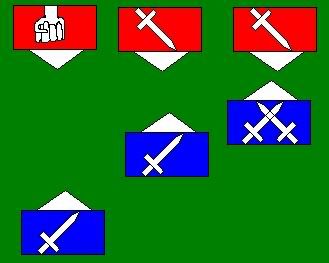
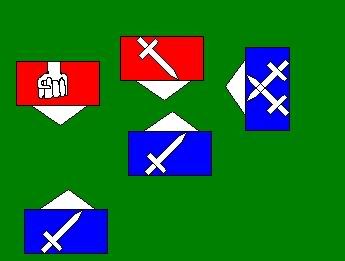
Then as the red basic unit charges the blue basic unit the superior unit is in a position to flank the incoming opponent.
By the time the opponent’s hammer unit charges you will be able to flee from the charge and flank with your superior unit easily beating it.
How to get the charge off We all know that in a fight between equals whoever charges usually wins and in the case of two hammer units this is amplified and expensive. If you move faster than your opponent it is easy to get a charge off. So how do you get the charge off on a unit that is your equal in combat but moves faster than you? In a vacuum it is impossible. You must use other units to help.
First off, read and reread the charge, fleeing, redirecting, overrunning, and perusing rules. Know the details because the details are what will allow you to get things to happen correctly.
If the charge range of your units is very close to or equal to your opponent’s then all you need to do is have a unit between the two of you flee from a charge (making sure you can’t be redirected into) and the opponent will come into your charge range. If the opponent doesn’t charge then just move in and charge him (its what you wanted isn’t it?).
Alternatively you could have multiple units each of which could beat the opponent on the charge but not when charged (seen below).
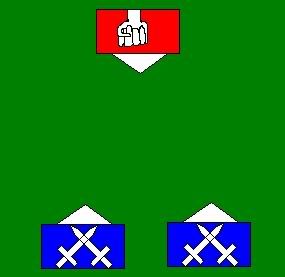
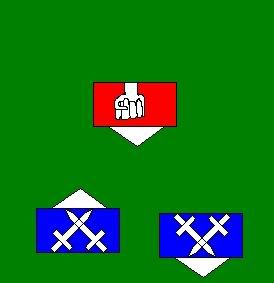
Hammer charges the unit on the left which flees. This leaves the unit on the right an easy charge.
If your charge range is nowhere near your opponent’s (half or less movement) then you need blocking units. The purpose of these units is to block any valid charges to the unit you don’t want charged. This includes overruns and redirects so keep those in mind.

To accomplish this you usually need to angle the blocking unit/units slightly away from your unit that will be charging. In the game of warhammer moving laterally is very slow so your opponent’s unit will have a hard time getting out of your way. Your own unit must be placed in such a way that when your blocking unit takes the charge and decides to run (and they will run) you can still charge your enemy if they hold or pursue. This works best the farther forward your blocking units are. You could also leave another blocking unit to take the impact from the overrun. This has the benefit of the opponent’s unit stopping exactly where you want it. Just make sure this unit has few wounds (small units work best) so that they don’t underdog you and cause your flank charge to fail badly.
When used right this strategy is almost unbeatable, only a really long overrun can defeat it. But to be fair we are talking about a 3v1 situation so it had better be worth it.
If your blocking unit is right next to the opponent’s unit of choice then it cannot escape at all. The reason for this is that you are 1 in away from their front so they can’t move forward (shown earlier). If you are 1 in away from their side so they can’t move to one side (the other is clear), they cant wheel because that takes them within an inch of your unit (they can wheel backwards by turning in place, wheeling, and turning back, but who cares, and they cant reform well because they must reform on the center and your preventing anything other than 90 degree turns. This gives you lots of time to walk forward and charge the unit with your own.
You can also use opponent’s units as blocking units. If they are properly placed then they will prevent the opponent’s unit from charging. Hard plan but take advantage of it when possible.
One thing to note: When a unit flees and is still in the charger’s charge range the charger must move its full movement through the fleeing unit (NOT in whatever direction they want) destroying it in the process. This means if your blocker unit is slow enough and close enough you will know exactly where the charger will end up. No questions asked. This can make planning a counter charge far easier.
The bait and flank The bait and flank is probably the most known strategy in the game, but it bears mentioning here. This is actually a minor variation on the above strategy. When faced with an enemy unit you cannot kill head on this is usually the strategy to adopt.
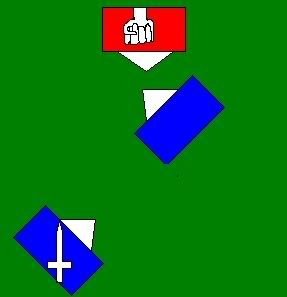
The core of this strategy is to have two units, one disposable and the other a superior unit. The disposable (bait) unit moves out in front of the hammer unit making sure to be in charge range. The other unit (the flanker) moves to a position so that when the hammer unit kills the bait the flanker will be able to hit the flank of the hammer. This usually requires a faster cavalry unit but not always. It is imperative that the hammer not be able to charge the flanking unit or the strategy will fail.
Getting the hammer unit to take the bait can be difficult. Generally, the more expensive the bait the more likely the opponent will go for it.
Pinning a unit Pinning a unit is done for the purpose of forcing it to not participate in a battle. Think of a unit that will kill anything it manages to fight head on charge or no charge. One rank of chose knights 7 wide with the war banner for instance. They will kill anyone. But they are very venerable to flank charges and the opponent knows this. This means the opponent will rarely fall for the bait and flank strategy that this calls for. But go ahead and perform the bait and flank. Odds are that your two units cost considerably less than the knights. The opponent cannot charge as this means death from the flank. So they will shuffle around. If you get your bait unit close enough to prevent shuffling then the opponent will not be able to move their hammer unit at all. It will be pinned in place unable to do anything. A fairly depressing place for such a powerful unit.
This is what normally happens against smart opponents when you try to perform the above strategy. Just make sure to use this time to bring up something that can charge his hammer unit and beat it before he figures a way around your pinning units.
The fork The fork is a relatively simple tactic to use. It is where one unit threatens two or more opposing units. It only works if the forking unit is defended or un-chargeable. The easiest way to do this is to move a large cavalry unit forward so that it threatens multiple infantry units. While not a particularly powerful tactic it is a away of giving you more options even though you don’t know your opponent’s plans. This way they must move to defend from your charge in multiple places which is far more difficult than defending one location.
Using large flyers Large flyers, characters on monstrous mounts, don’t really fit into any generic category. They perform their own functions in their own ways. So how do you use these units?
Lets start by outlining the common characteristics of these units. They usually have 4-6 wound mounts with toughness 5 or 6. Between the rider and the mount they average 9 or so attacks, all high
WS all high
STR. They all fly, they are all large targets, and they all cause terror. They are all US 5 or higher.
Unit strength 5 is a good thing because it breaks ranks. This is necessary because otherwise only the beefiest of characters will be able to beat a ranked unit head on by themselves. So you should send your large flyer after anything that isn’t a fully ranked unit. In general they can handle most other targets. The best targets are flanks, fast cav, war machines, and skirmishers. These units will almost always break on the charge from your unit.
Threats to your large flyer are very small. Only war machines (especially cannons), stubborn units (you will break eventually), and poison are really concerning. Any hammer unit powerful enough to beat you can easily be avoided with your superior maneuverable.
If you want you can use your large flyer the same way you use every other superior unit or fast unit. It can perform both functions well. Most people end up doing this as it is very effective.
You could use it to just romp around causing terror. This is a valid use but misses out on many of the great abilities the large flyer has to offer.
Or, you could do things that only the large flyer can accomplish. The number of tricks you can pull with your large flyers is more than any other unit. With the ability to move 20 in and charge past other units (or over them) you can do almost anything. You are only limited by line of sight from whatever position you are in and where the nearest cannon is. Here are a couple of the more favored tricks
1). Fly to behind a piece of terrain located half way up one flank. Next turn fly over the terrain, into the opponent’s deployment zone and face his entire battle line. This gives you a choice of 3+ flanks (you have a really long charge range) to charge meaning he has to either turn to face you (letting your advancing units get a flank charge), ignore you (letting you crush the units of your choice), or run away from you (usually bunching his units in a corner).
2) Advance behind an anvil unit. This lets you walk forward with the rest of your army knowing that no matter what you cannot be but are free to charge anything in your ark.
3) Sticking the tiniest corner of your flyer out from behind terrain giving you line of sight to the target of choice. This means your line of sight is limited to the unit you want to charge but nobody can shoot you.
Using other large units Other large units almost always fall into the category of hard to kill, stubborn, terror causing, medium hitting power units. They cannot break units much but will hold up all but the hardest units.
They are basically anvil units with two advantages. One, they cause terror so fear will not break you. Two they are very hard to kill so grinding them down with numerous
str 4 attacks doesn’t usually work.
The downsides are that they are large targets which are begging for war machines to shoot them and they are venerable to units with a few high
str attacks (5 or greater base strength required to be threatening) or many poisoned attacks when the large guy doesn’t have any armor (giants).
Other than that they are usable just the same as any other anvil unit.
Making the enemy break ranks Many strategies involve multiple units advancing together in some sort of formation. This could be a denied flank with 4 units close to the board edge with their flank protected by an anvil unit.
Breaking these formations or getting the enemy to break ranks and abandon their formation is a challenge. There are a few ways this can be done.
Frenzy. Any frenzied units must pursue you so if they are in formation and you charge they have to pursue out of the formation. Most opponents know this so it doesn’t work well.
Charge them, lose, and hope for a failed restrain test. This works one out of 10 or so times so don’t count on it. It will work more often when the unit running away is more expensive or carrying banners (they don’t get to keep the banner if they don’t pursue) but generally will only work when the enemy makes a mistake.
Fear. Large fear causing units can break holes in most formations. If you are lucky to have such a unit recognize its strength and use it.
Cunning charges. There are two ways the formation will be arranged. Staggered or in a line. If they are in a line you can charge multiple units at once and attempt to minimize their rank bonus. If they are staggered you can charge the forward units in the flank and easily crush them creating exploitable openings. You can even charge in the flank and front so that both units pursue forward and don’t expose their flanks.
What to do about characters I have tried to stay away from tactics dealing with characters because they are so variable that it is impossible to outline them all. Mainly characters are used to increase the capabilities of units. Aside from that there aren’t to many things to do with characters. Many people place characters in the corner of a unit so they get to fight if they are charged in the front or the flank. This is particularly good for really hard to kill characters in a single rank of troops, say an old blood in a unit of cold ones. If the flank is charged all attacks go against the impossible to kill old blood instead of the 3+ save cold ones. Most people put champions in any unit they plan on having a character in to save them from bad challenges and to allow them to fight when champions challenge them.
There are a few tricks to fighting against characters. Most characters require line of sight. Mages need it to use most magic and fighters are in the front rank of some flightier unit. The only ways to kill fighty characters is to beat their unit in combat with them in it or flank the unit and run it down before they get to fight. Both are reasonable tactics and are the same ways you deal with all hammer units. Mages and
BSBs on the other hand have a couple more tricks you can pull on them. The favorite by far is to charge a unit with multiple attacks into the unit they are in and direct everything at the character of your choice. Both of these character types are usually lacking in armor so you have a more than fair chance of killing out one two wound armor less char before you break and run. Almost every army has something that can do this from pairs of great eagles to night runners.
You can also throw units into combat with a mage’s unit for the purposes of sticking it where it is. With the exception of skaven once the unit is in combat the char can’t leave the unit and will most likely be stuck with no/bad
LOS. This means the mage will be significantly diminished in capacity unless it can ignore
LOS. This also prevents
BSBs from advancing with the rest of the army.
Under-dogging Under dogging isn’t really a strategy so much as a mistake that many people fall into. Lets say your fighting a unit of 20 chaos chosen on foot with 25 orcs and you can chose to throw a unit of goblins into the flank. Goblins in the flank will get you a +1
CR for flanking and +2 for the ranks you will break, but will kill nothing. In return they will probably take 4 casualties for a net result of -1. Throwing the goblins into combat is a mistake. They detract from the combat and add nothing. A cunning opponent will direct as many attacks into the goblins as they are easier to kill than the orcs. In general before charging it is a good idea to try to think what will happen and not charge if it simply makes the situation worse.
This is all of the generic tactical advice I have come up with so far. If you think there are any mistakes/omissions please let me know and I will try to include it in a later version. All ideas are welcome.